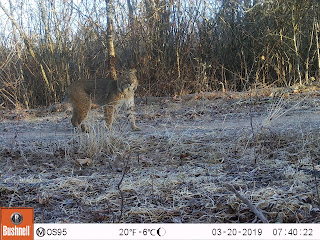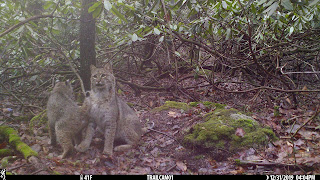When University of Rhode Island
research scientist Amy Mayer captured a bobcat in Charlestown in 2016, she had
no idea where it would lead her or what she would learn from it. But after
checking its health, taking a blood sample and placing a radio-tracking collar
around its neck, she released the animal as part of a five-year study – the
first of its kind in Rhode Island – to learn where the wild cats are found in
the state and what habitat they prefer.
It didn’t stay in Charlestown long.
“It ended up spending most of its
time in Saunderstown near Casey Farm,” said Mayer, whose research is conducted
in collaboration with the Rhode Island Department of
Environmental Management.
“The interesting thing is that it was always hanging around neighborhoods. I
spent a lot of time driving around Plum Beach and other nice neighborhoods
keeping track of it.”And then it disappeared. She couldn’t relocate it for days and days. Using a telemetry antenna dialed into the collar’s radio frequency, she had to be within a third of a mile of the animal to detect its location. So she kept driving farther and farther afield until she heard the distinct beeping noise that indicated she had found it. In Snug Harbor, where it spent the next several months.
“We think it moved because of some
sort of resource availability,” Mayer speculated. “The habitat in the two areas
isn’t all that different, so maybe it couldn’t find enough food and just
decided to move. Or maybe it was competition from another bobcat that made it
shift locations.”
Whatever the reason, it helped Mayer
gain a better understanding of the ecology of Rhode Island’s only wild feline.
Bobcats are the most widely distributed native cat
in North America, living in deserts, mountains, prairies and coastal regions.
Weighing up to 35 pounds, they eat a wide variety of small mammals and other
prey. In Rhode Island they are believed to consume mostly rabbits,
squirrels
and rodents. The
animals have been sighted in nearly every community in mainland Rhode Island,
but their hotspots are in South County – mostly South Kingstown, Charlestown
and Westerly.
And their numbers are increasing.
“It’s really hard to get a good
population estimate, since to do that you have to be able to do a
trap-and-recapture study, and we’ve learned that they’re very difficult to
trap,” Mayer said. “Or you have to be able to identify individuals from photos,
which is also difficult because their spot patterns aren’t very clear. But I’d
estimate the population to be somewhere between 50 and 100, probably closer to
50.”
To learn more about them, Mayer set up
100 trail cameras around the state – including 40 in South County – to detect
where they are found. Bobcats were photographed at 20 of the South County sites
and at a total of 40 statewide, but in most cases the animals were only
photographed once or twice at each site.
“They move around a lot and don’t park
in any one area for long,” she said. “They travel pretty widely, especially the
young ones that don’t have an established territory yet. We trapped one young bobcat
near URI, and then it spent time in Saunderstown before going all the way to
Stonington, Connecticut, and back.”
Loss of habitat is typically the
greatest threat to large animals, but bobcat numbers in Rhode Island have
increased over the last 80 years at a time when residential development in the
region has been quite high.
“It’s a weird conundrum that habitat is
shrinking, but for whatever reason, they’re able to survive and they’re doing
well,” Mayer said. “In the 1950s they were classified as rare, but not
anymore.”
The biggest threat facing the animals
now is road mortality. As many as 10 bobcats are reportedly struck and killed
by vehicles around the state each year. Others probably go unreported. Route 1
through South County is an especially dangerous place to be a bobcat.
“Of the animals we tracked, they didn’t
necessarily avoid areas of high road density. Maybe that’s because roads have
the shrubby edge habitats along them that bobcats prefer,” said Mayer.
Trapping of bobcats for their fur is
prohibited in Rhode Island, and there is no evidence to suggest that they are
poached on a large scale, though Mayer said that a bobcat is occasionally mistaken
for a deer and shot during hunting season.
Rhode Islanders who are alarmed at the
growing number of bobcats in the region have little to worry about, according
to Mayer. "They tend to be secretive, so most people don't even notice when they are in the neighborhood," she said. "People should use the same precuations they do with any wild animal - don't leave pets out unattended, especially in the evening, and keep sources of food secured indoors."
While the objective of Mayer’s camera trap study was to learn about bobcats in the state, the cameras also captured more than 200,000 images of other animals, including deer, raccoons, opossums, turkeys and more.
While the objective of Mayer’s camera trap study was to learn about bobcats in the state, the cameras also captured more than 200,000 images of other animals, including deer, raccoons, opossums, turkeys and more.
“We got photos of fishers at 95 out of
the 100 sites,” she noted. “We’ll be able to use all of that data for studies
of the distribution of other animals in the state as well.”
Most importantly, however, biologists
now know a great deal more about Rhode Island’s elusive bobcat.
“We started off with zero information
about bobcats in the state, and now we have a huge database of information
about them to work from,” concluded Mayer. “It will be super useful for DEM to
keep track of their distribution, and we can combine our data with other
studies taking place in other states in the area. It has definitely been a successful
project.”
This article first appeared in the June 2020 issue of South County Life magazine.


No comments:
Post a Comment